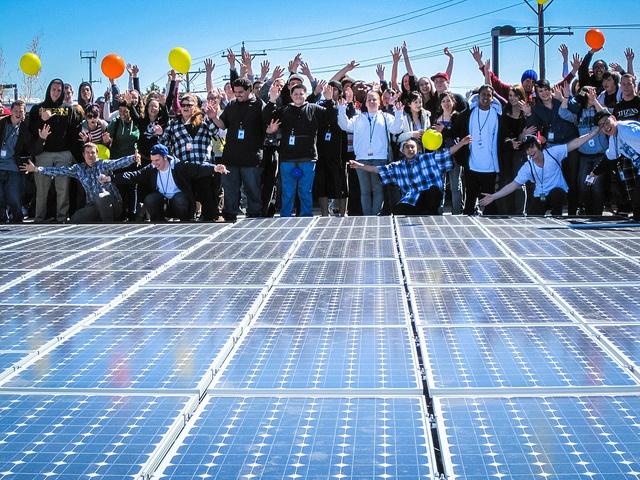
By Jake DiRe
Out of the 125,000 K-12 schools in the United States, over 3,700 are running on solar power. Three-thousand of these schools installed their solar power systems within the past six years, as solar technology continues to become less expensive and more sophisticated.
This trend in powering our schools reflects the growing recognition by district and state officials that photovoltaic electrical systems offer significant financial and environmental benefits. Here are four key reasons why more schools are making this transition.
Solar-powered schools are more affordable
Each solar-powered school saves an average of $21,000 per year in utility bills, which totals $77.8 million per year nationwide. Schools can pass these savings on to the students in the form of subsidized laptops, tablets and other classroom resources, or savings can be used to provide over 2,000 teaching jobs throughout the United States.
A financial analysis notes that 450 more school districts could each save approximately $1 million in energy costs over the next 30 years if they installed a solar electric power system. Schools could realize further savings if they added solar thermal water-heating systems to their existing infrastructure.
Architecturally, most schools are well-suited to the addition of solar panels. They are frequently one-story buildings with broad, flat roof surfaces that make the installation of solar electric or water-heating systems easy. Schools can also install solar canopies in parking lots, providing the benefit of shade while producing substantial amounts of electricity on land that is already in use.
Solar power is better than other alternative energy sources
As the nation moves forward with sustainable energy, wind and hydropower are also receiving fresh attention. While these energy sources have a place in the overall long-term picture, the attributes of solar power continue to keep it at the forefront of alternative energy sources.
Hydropower: Unlike solar power, which can be generated on an individual site, hydropower requires a collective regional effort and a substantial expenditure on infrastructure. Furthermore, the building of dams and other waterways creates environmental disruptions that offset the effort toward sustainability.
Wind power: While large-scale wind farms are one valuable element in our nation’s energy future, wind power tends to be impractical on a single-site basis. Wind power systems require expensive construction and maintenance, and they include many moving parts that can wear out or break. Furthermore, the tall towers are often considered unsightly and generate a push-back from neighbors who object to the disruption of the visual landscape. Additionally, the noise of the windmill’s blades impinges on people’s awareness, and they can cause a high mortality rate in the local bird population. Given these objections, school districts are unlikely to find strong support for wind-powered systems to generate electricity.
Solar power: Solar power has few of the drawbacks of other sustainable energy sources. With no moving parts, solar electric systems require almost no maintenance. They are completely scalable, down to the smallest building or even to individual appliances. Entirely silent, photovoltaic systems don’t create a sensory distraction to people nearby, and they are free of environmental hazards to water supplies or wildlife.
Solar-powered schools help the environment
Every hour, the sun radiates enough energy onto the Earth to cover the entire planet’s energy needs for a full year. This abundant, unlimited energy supply is the power source of the future, and schools that make use of it are setting an example by reducing water pollution and greenhouse gases.
Solar-powered schools reduce water pollution
Traditional power plants require a large amount of fresh water, which is quickly becoming a scarce resource. Furthermore, 72 percent of water pollution is created by coal-fired power plants, and these water-borne toxins contaminate the environment and cause health problems in people who use the water. Hydraulic fracturing, which uses massive amounts of water to extract oil and gas from the ground, can also cause contamination of drinking water. Solar power avoids the need to use fresh water for extraction or cooling purposes and positions schools in the role of responsible guardians of shared natural resources.
Solar-powered schools reduce greenhouse gases
Scientists consider fossil fuels to be the primary cause for global climate change. Each new solar power system reduces our total dependence on fossil fuels and decreases the amount of greenhouse gases released into the atmosphere. Current methods of generating electricity are responsible for 31 percent of the country’s greenhouse gas emissions, and the EPA states that the electricity generation industry is the single largest source of excess carbon dioxide gas being released into the environment.
Schools have a natural role within their communities to display leadership in building a future that is environmentally sustainable. The project of installing a solar panel array at a school does more than simply save money and reduce environmental pollution. It provides an educational opportunity for students to learn about alternative energy production, become more scientifically literate and increase their awareness of our planet's limited resources.
Image credit: Flickr/BlackRockSolar
Jake DiRe is the co-founder of EcoMark Solar, a solar panel installation and financing company in Colorado. For more on solar energy, follow EcoMark on Twitter.
TriplePundit has published articles from over 1000 contributors. If you'd like to be a guest author, please get in touch!














